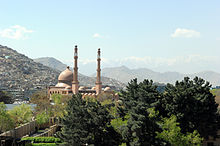
Back Arquitectura de Afganistán Spanish معماری در افغانستان FA په افغانستان کې معماري PS Архитектура Афганистана Russian Afg'oniston arxitekturasi UZ

| Part of a series on the |
| Culture of Afghanistan |
|---|
 |
| History |
| People |
| Languages |
| Mythology |
| Cuisine |
| Festivals |
| Religion |
| Sport |
The architecture of Afghanistan refers to a distinct style of architecture of the modern country and its predecessor states.[1] As the connection between the three major cultural and geographic centers of Central Asia, the Indian subcontinent, and the Iranian plateau, the boundaries of the region prior to this time changed with the rapid advancement of armies, with the land belonging to a vast range of empires over the last two millennia.[2][3][4]
The diversity of Afghan history allows for the diverse and at the same time unique style that exists in the country's architecture and architectural remains, with influences ranging over time from Greek to Persian, to Indian and European in recent centuries.[2][3] A range of religious influences over time are also reflected, with evidence primarily exhibiting early Buddhist, Zoroastrian and Islamic inspiration.[1][2][4][5]
- ^ a b Ball, Warwick (2008). The Monuments of Afghanistan: History, archeology and architecture. London: I.B. Tauris. ISBN 978-1-85043-436-8.
- ^ a b c Runion, Meredith (2017). The History of Afghanistan, 2nd Edition. Santa Barbara, California: ABC CLIO, LLC. ISBN 978-1-610-69778-1.
- ^ a b Knobloch, Edgar (2002). The Archaeology & Architecture of Afghanistan. Stroud, Gloucestershire: Tempus. ISBN 0-7524-2519-6.
- ^ a b Petersen, Andrew (1995). Dictionary of Islamic Architecture. London: Routledge. ISBN 0203203879. OCLC 50488428.
- ^ Kia, Ardi (2015). Central Asian Cultures, Arts, and Architecture. Lanham, Maryland: Lexington Books. ISBN 978-0-7391-9928-2. OCLC 921249814.